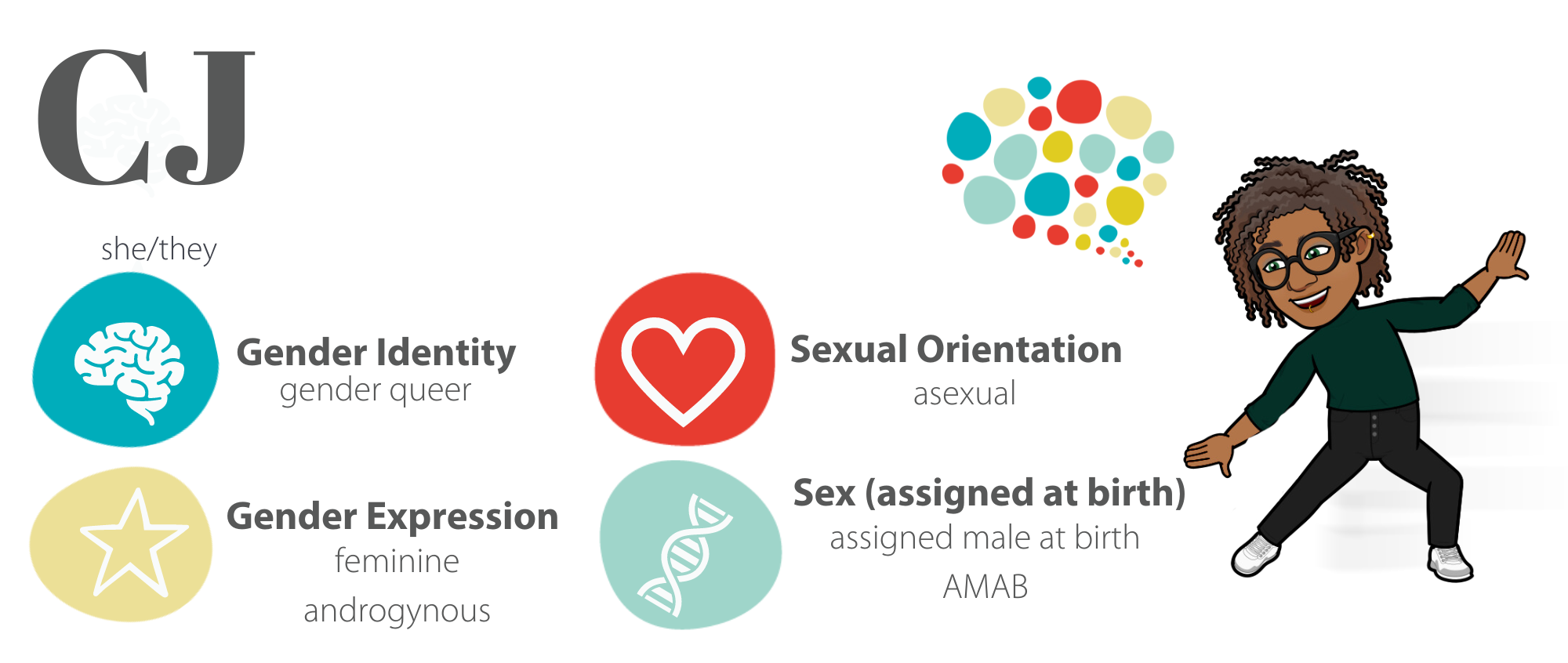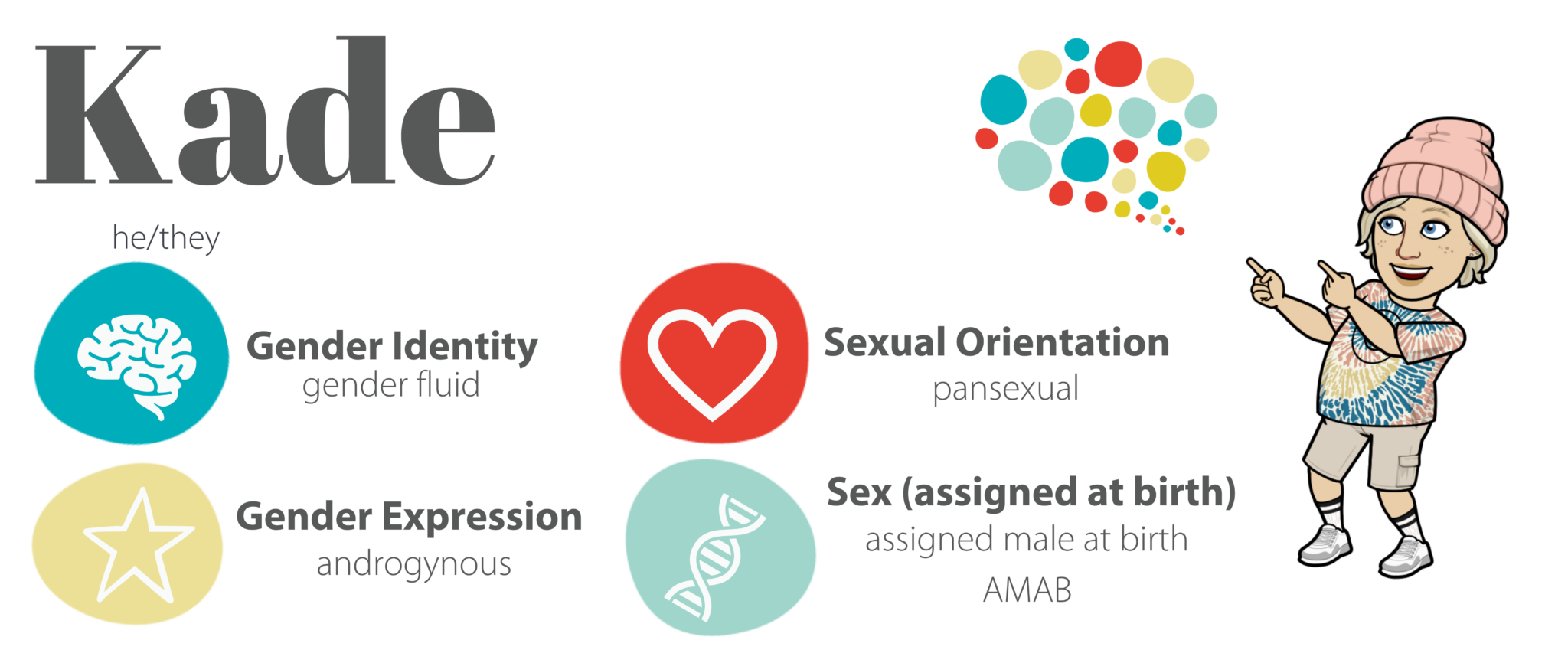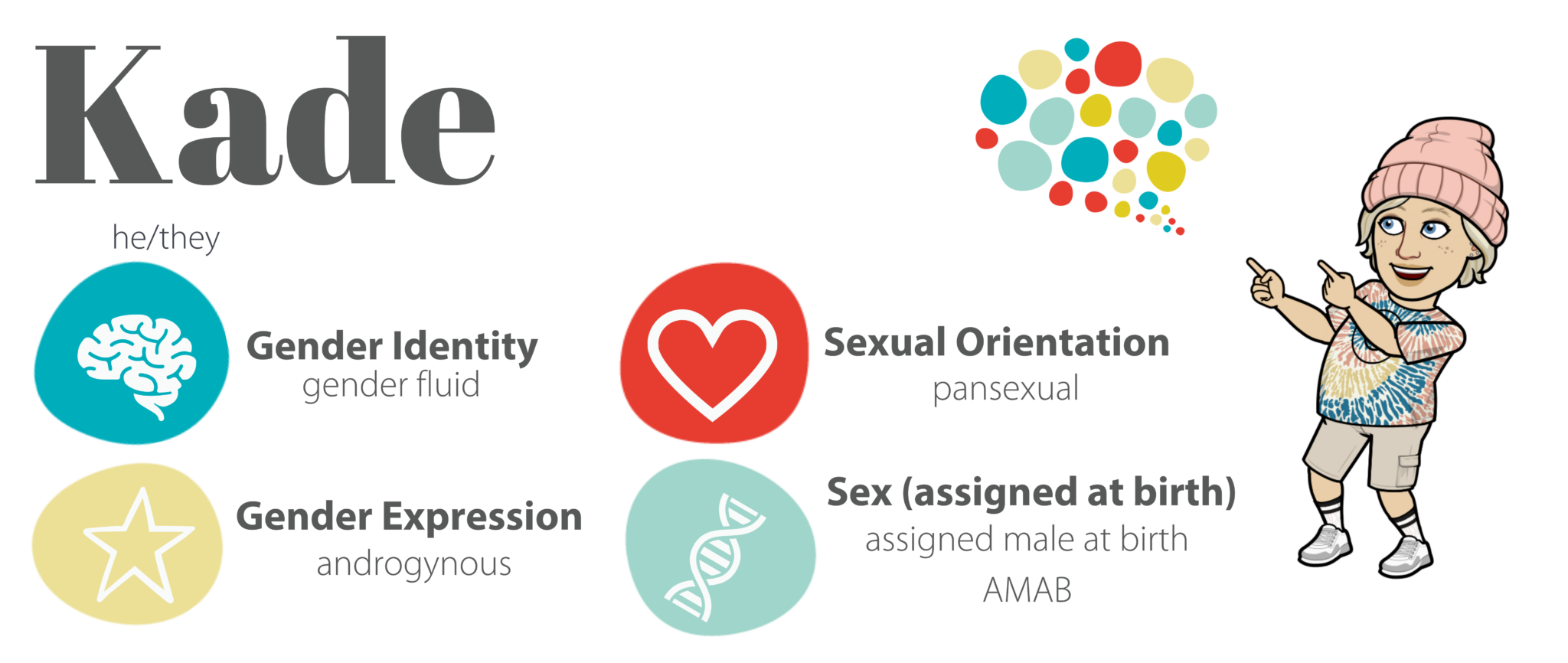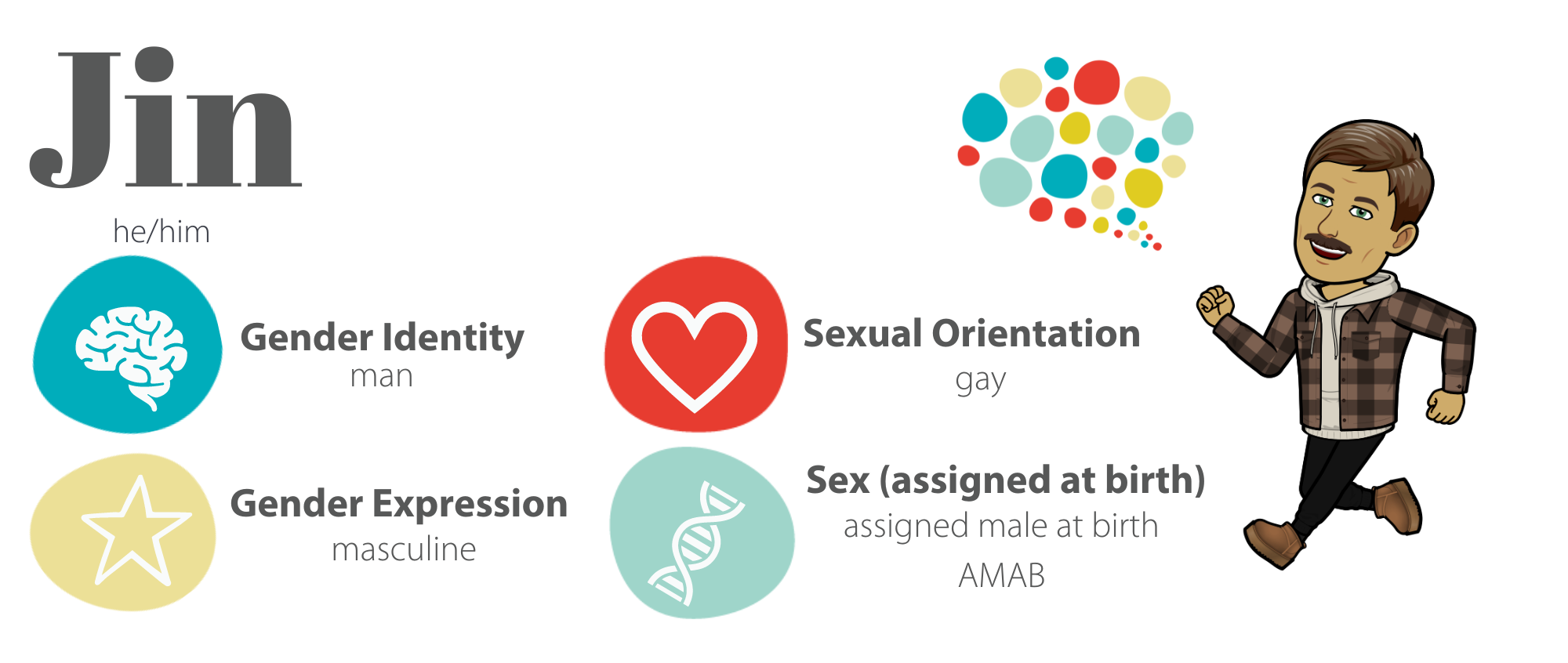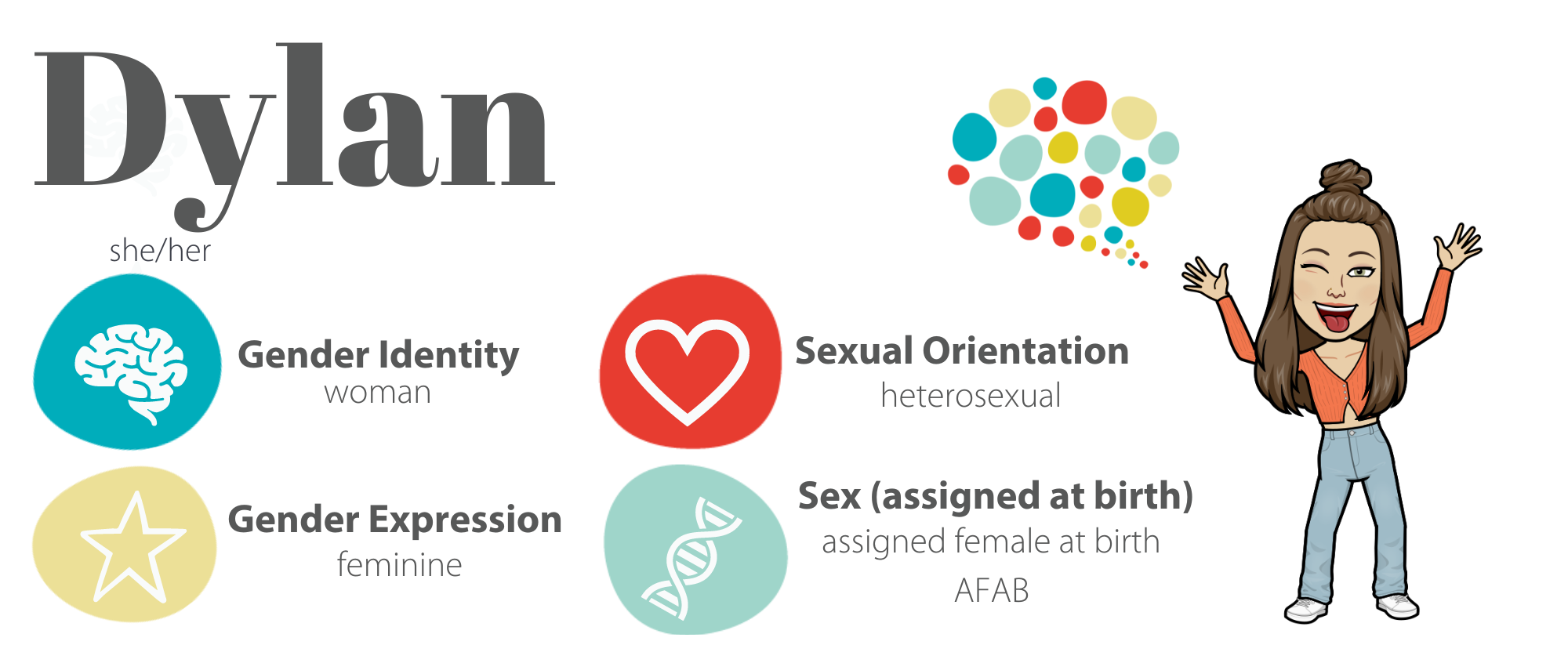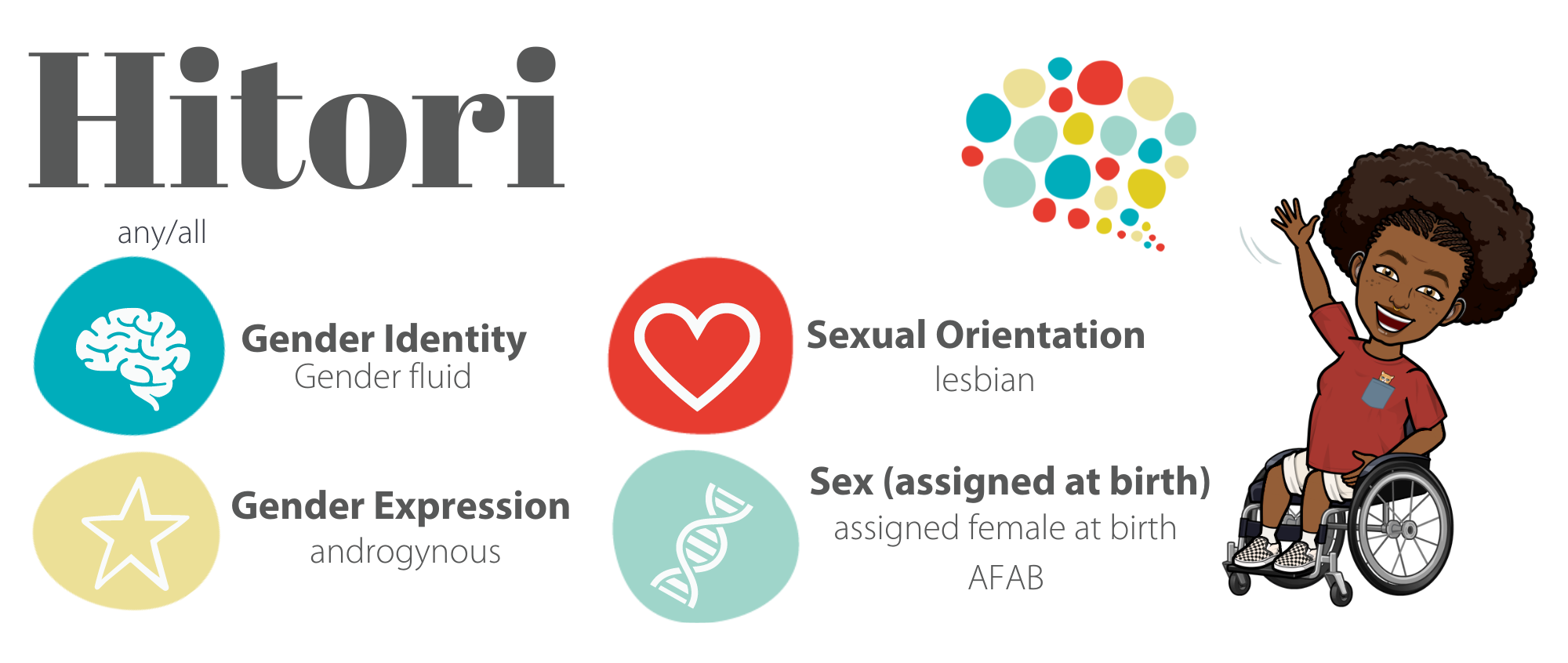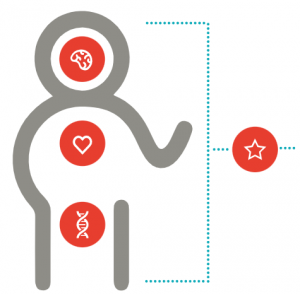Sexual Orientation
Everyone has a sexual orientation. Your sexual orientation refers to your emotional, physical and sexual attraction to others. It’s a part of who you are. Some people know their sexual orientation from a young age, while others may discover it later in life. It can remain the same or change over time.
Gender identity is different from sexual orientation. Gender identity is about your internal sense of who you are and how you express that to the world. Visit the gender identity and expression page to learn more.
The examples below illustrate that a person’s identity is a combination of gender identity and expression, sexual orientation and sex. People use words like heterosexual, lesbian, queer, and asexual to define their sexual orientation. Definitions of these words and more can be found here.
To see how gender identity and sexual orientation relate to each other, see the Every Body Tool.
Many people use words that assume everyone is heterosexual (straight). This is called heteronormative language. For example:
- a form that asks for ‘mother and father’s names’ assumes that all kids have two straight parents.
- saying ‘when a girl grows up and has a boyfriend’ assumes that all girls are straight and are attracted to boys.
- talking about sexual activity only in relation to penis-in-vagina sex.
This wording strengthens stereotypes and assumptions about who people are and how they identify. It can make people who don’t fit these expectations feel abnormal or different. Using inclusive language avoids these assumptions. It shows that you embrace and respect diversity as a strength. You can’t assume someone’s sexual orientation by looking at them.
When you read about sexual orientation, you might see acronyms like 2SLGBTQI+ or LGBT. These acronyms stand for a range of gender identities and sexual orientations. It can take some practice to remember what each letter means.
- 2S is for two-spirit
- L is for lesbian
- G is for gay
- B is for bisexual
- T is for trans/transgender
- Q is for queer or questioning
- I is for intersex
- +, or sometimes *, is for all the other identities that aren’t spelled out in the acronym, like non-binary, pansexual, intersex or asexual
Taken together, this acronym means sexual and gender minorities. For more on words about gender, like transgender, see the Gender Identity and Expression page.
Another acronym you might encounter is SOGIE which stands for Sexual Orientation, Gender Identity, and (Gender) Expression. SOGIE recognizes that everyone has a sexual orientation, gender identity, and gender expression, so it isn’t used as a replacement for 2SLGBTQI+.
Lived Experiences of Sexual Minority Youth
Many young people who identify as sexual minorities face challenges in their lives. They may fear how their families and friends will react if they’re open about their sexual orientation. Making their orientation public makes it more likely that someone will bully, harass, or discriminate against them. Supportive families, schools, and communities are crucial in helping 2SLGBTQI+ children and teenagers succeed at school and in their overall well-being.
Coming out can pose serious safety risks, particularly for young people who can’t support themselves financially. Some may even be forced to leave their homes after coming out, greatly increasing their chances of substance abuse, self-harm, becoming unhoused, or dying by suicide.
Research also indicates that 2SLGBTQI+ students often do not feel safe at school. They face verbal and physical harassment and abuse from others in their school environment.
For example, in a recent survey of Canadian students (2021):
- 48% of 2SLGBTQI+ students felt unsafe at school
- Students with an 2SLGBTQI+ parent were three times more likely to be physically harassed about their sexual orientation than students with straight parents
- 42%% of 2SLGBTQI+ students had been verbally harassed about their sexual orientation
- 30% of 2SLGBTQI+ students had been cyber-bullied vs 8% of straight cisgender students
- 27% of students reported that “most” students use homophobic language, which is higher in Grade 8 and declines as students get older
- Nearly 40% of students heard homophobic comments like “That’s so gay” daily
Kids and teens supported at home and school are more likely to stay in school, have stable living environments, and have better mental and physical health. When a school’s students, staff and parents ensure it is an inclusive space, 2SLGBTQI+ students can feel safe and thrive.
All kids have the right to feel safe and included in their community. If your child is the target of bullying, they and/or you should:
- tell someone they trust.
- keep a record of what’s going on (e.g., record each incident, keep examples of online bullying).
- stay safe and not fight back.
- find support with the school or broader community (e.g., join a GSA/QSA).
- know their rights as a member of the community (e.g., check out school anti-harassment policies and student code of conduct).
For more detailed tips for students, see Homophobic Bullying: Prevention Tips for Youth
What Parents Can Do
Parents can be allies in helping their 2SLGBTQI+ child grow up healthy and resilient. Parents can help their kids learn to recognize stigma, discrimination and bullying. More importantly, they can help their kids learn ways to cope. To learn more, see Bullying.
Tips for Parents:
- Educate yourself. It’s important to educate yourself about sexual orientation. There are some great online resources (see Additional Resources) that you may find helpful. Once you have educated yourself, think about how to challenge assumptions and prejudice.
- Be a role model and set a positive example for those around you. Ensure your humour and language is supportive of the 2SLGBTQI+ community. Use gender inclusive language and don’t assume someone’s sexual orientation.
- Be supportive and respond in a positive way. It can take a lot of courage for someone to come out. If your child or teen comes out to you, be respectful, open, and non-judgmental. Let them know you’re here for them and that you love them.
- Take action. Recognize and report inappropriate behaviour or actions targeted at your child. Talk to your school if your child’s being bullied or harassed.
- Get support. Find out what resources and support may help your child and you. Offer to go with your child for in-person services so they don’t feel alone.
- Get involved. Advocate for human and civil rights for everyone. 2SLGBTQI+ rights benefit us all. Stand by your 2SLGBTQI+ child.
- Be an ally. An ally is a person who promotes or supports the human, civil and sexual rights of sexual and gender minorities. All the points above are things you can do to be an ally for your 2SLGBTQI+ child. Let your child tell you how you can be an ally for them. Remember, even the smallest actions can bring about changes.
Gay-Straight/Gender-Sexuality/Queer-Straight Alliances (GSAs/QSAs)
Many sexual minority kids do well in their school environments and are proud of who they are. They have positive and productive coping strategies and can be role models and sources of support for other 2SLGBTQI+ students.
GSAs/QSAs are student groups found in some K–12 schools. These groups create supportive and safe conditions for sexual and gender minorities and their supporters. Schools that choose to start a GSA/QSA:
- are looking for ways to create a safer school space.
- reduce bullying.
- support human rights and social justice related to sexual orientation and gender diversity.
- ensure regular meetings in a safe space, have an adult supervisor/sponsor and name the club.
To read more, see Positive Impacts of GSAs.
The Education Act in Alberta states that all schools are required to protect the establishment of a GSA/ QSA with principal support in a timely manner.
If your child wants to start a GSA/QSA, they can take the following steps:
- Find a teacher or staff sponsor.
- Meet with the school administration.
- Find other students who may want to help start the group.
- Pick a meeting space.
- Advertise the group.
- Plan and hold a first meeting.
- Set up ground rules/group agreements.
- Plan for the future.
For more information on GSAs/QSAs, see the Additional Resources page.
Words You May Hear
Below is a list of common terms and definitions you may hear related to sexual and gender diversity. These terms are not labels. When speaking with people, it’s important to listen to and use the terms they use to describe themselves, not impose terms on others.
- Ally: A person who advocates for the human rights of sexual and gender minority people by challenging discrimination and heterosexism.
- Asexual: A person who does not feel sexual attraction. They may or may not feel emotional/romantic attraction.
- Bisexual: A person who has emotional, physical and/or sexual attraction to people of their own gender and other genders.
- Coming Out: Telling people about one’s sexual orientation or gender identity. Also known as ‘coming out of the closet’.
- Gay: A person who has emotional, physical and/or sexual attraction to people of the same gender. This term is most often used for a man who has an emotional or sexual attraction to men.
- Gender Expression: How a person presents their gender to the world. This can include how they look, the name they use, the pronouns they use (e.g., they, them, she, her, he him, zie, zim) and their social behaviour.
- Gender Identity: A person’s internal sense of identity as a woman, man, both, fluid among genders, or no gender, regardless of their sex.
- GSA/QSA: (Gay-Straight/Gender-Sexuality/Queer-Straight Alliance): Student groups in some K-12 schools. These groups create supportive and safe environments for sexual and gender minorities and their supporters.
- Heteronormativity: The assumption that all people are heterosexual and that this is the norm, e.g., all married people are husband and wife
- Heterosexism: Discrimination based on the belief that all people are heterosexual. Also, includes the belief that this is the normal and/or superior sexual orientation.
- Heterosexual (Straight): A person who has emotional, physical and/or sexual attraction to people of the opposite gender, to their own.
- Homo-/Bi-Phobia: Fear and/or hatred of people who are gay, lesbian or bisexual. Often shown through prejudice, discrimination, bullying, intimidation or acts of violence.
- Homosexual: An outdated or clinical term for a person who has emotional and/or sexual attraction to people of the same gender. Terms like ‘gay’ ‘lesbian’ or ‘queer’ are more commonly used now.
- Inclusive Language: Language that does not assume gender (e.g., ‘partner’ instead of ‘boyfriend’ or ‘girlfriend’, ‘parent’ instead of ‘mom’ or ‘dad’, the pronoun ‘they’ instead of ‘he’ or ‘she’).
- Intersex: An umbrella term used when the reproductive, sexual or genetic biology of a person is unclear, not exclusively male or female, or otherwise does not fit within traditional definitions of male or female.
- Lesbian: A woman who has emotional, physical and/or sexual attraction to women.
- Outing: Making another person’s sexual orientation or gender identity public without that person’s permission or knowledge. This can be harmful to a child or teen if they come from a non-supportive home environment.
- Pansexual: A person who has emotional, physical and/or sexual attraction to people of any gender.
- Queer: A reclaimed term used by some people who identify as a sexual and/or gender minority. It’s also used as a positive, inclusive term to describe communities and social movements.
- Questioning: A person exploring, or unsure of, their sexual orientation or gender identity.
- Sex: Categories (male, female) to which people are typically assigned at birth based on physical characteristics. Some people may be assigned intersex, when their reproductive, sexual or genetic biology doesn’t fit the traditional definitions of male or female.
- Sexual Orientation: A person’s emotional, physical and/or sexual attraction to others. It can change and may or may not be the same as a person’s sexual behaviour.
- Two-Spirit: A cultural term some Indigenous people use to mean a person has both a male and female spirit. It may include concepts of spirituality, sexual orientation and gender identity.
See Gender Identity and Expression for more related terms.
Terms to Avoid & Alternatives
“That’s so gay”: People often use words and phrases like “that’s so gay” casually. However, these words play a part in 2SLGBTQI+ people feeling alienated, isolated, and discriminated against. People use these words to describe something or someone that is bad, unwanted or negative. Connecting ‘gay’ with things that are negative is the problem. That’s why you shouldn’t use this phrase.
“No Homo”: This phrase is often used to stress the speaker’s heterosexuality or masculinity, to avoid being perceived as 2SLGBTQI+ . This reinforces the negative idea that to be 2SLGBTQI+ is bad.
Fag, Faggot, Dyke, Homo, Fairy, Lez, Puff and other similar words: These are offensive words. They dehumanize people and should never be used. Regardless of the intent, if the person receiving these words experiences them as negative, that’s what matters.
Homosexual, homosexuality: These are dated terms that may be offensive. Homosexual means someone who has emotional, physical and/or sexual attraction to people of the same gender. Use lesbian or gay instead.
Lifestyle: There is no single lesbian, gay, or bisexual lifestyle. Using the term lifestyle suggests that sexual orientation is a choice or a phase when it isn’t. It’s often used to downplay the rights and needs of lesbian, gay, or bisexual people. Use sexual orientation instead.
Sexual Preference: The term sexual preference suggests that being lesbian, gay or bisexual is a choice when it isn’t. Sexual orientation is the word that describes an individual’s physical, romantic and/or emotional attraction to others.

